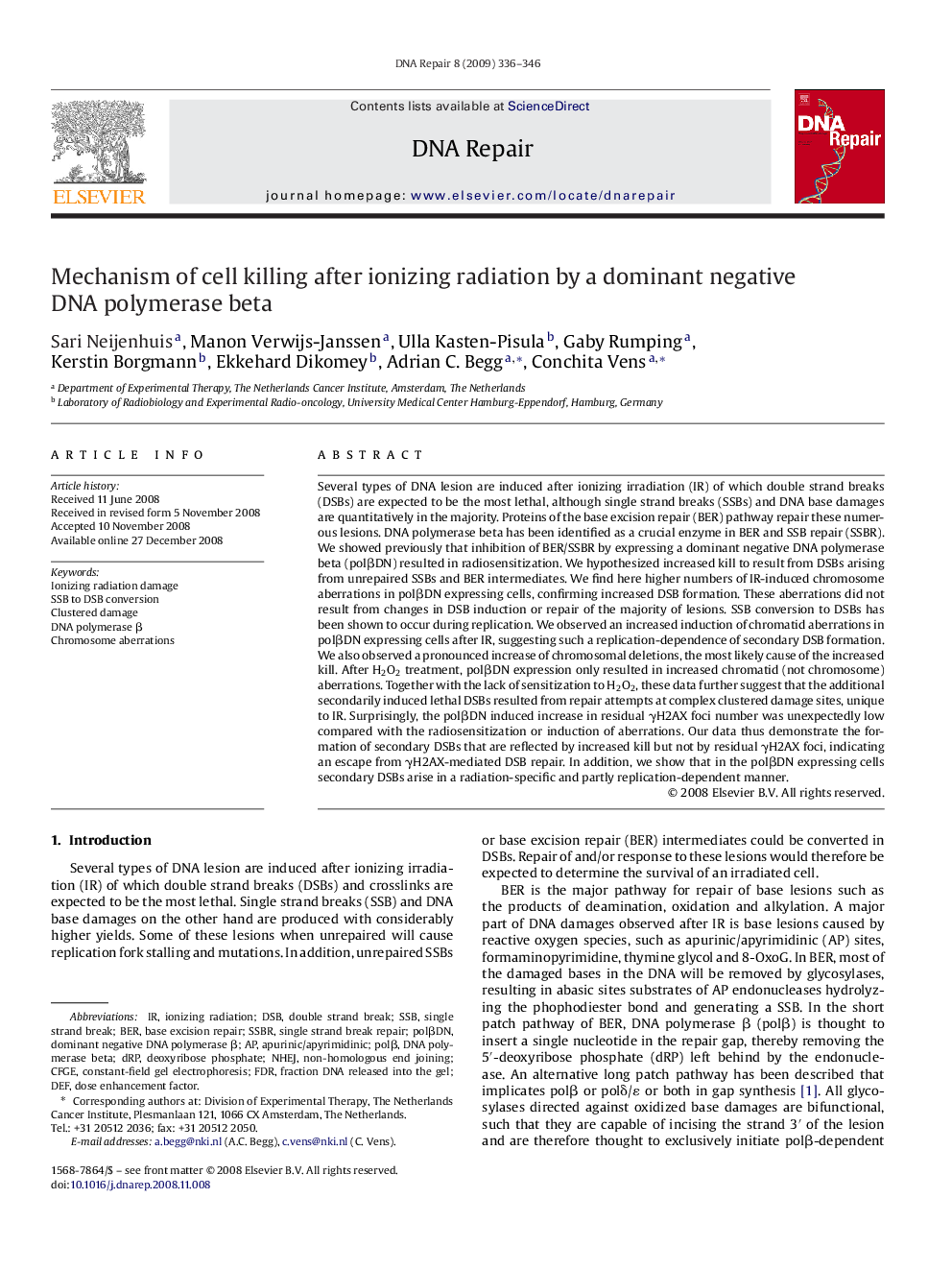| کد مقاله | کد نشریه | سال انتشار | مقاله انگلیسی | نسخه تمام متن |
|---|---|---|---|---|
| 1980643 | 1061870 | 2009 | 11 صفحه PDF | دانلود رایگان |
عنوان انگلیسی مقاله ISI
Mechanism of cell killing after ionizing radiation by a dominant negative DNA polymerase beta
دانلود مقاله + سفارش ترجمه
دانلود مقاله ISI انگلیسی
رایگان برای ایرانیان
کلمات کلیدی
DSBFDRNHEJBERDEFDRPClustered damagedeoxyribose phosphateSSBSSBRapurinic/apyrimidinic - apurinic / apyrimidinicDNA polymerase β - DNA پلیمراز بDNA polymerase beta - DNA پلیمراز بتاPolβ - PolbaChromosome aberrations - اختلالات کروموزومیionizing radiation - تابش یوننده یا پرتوهای یونیزانSingle strand break repair - تعمیر مجدد رشته تنهاbase excision repair - تعمیر پایه پایهdouble strand break - شکست دو رشتهsingle strand break - شکستن تک رشتهnon-homologous end joining - عدم پیوستن انتهای غیر همولوگ
موضوعات مرتبط
علوم زیستی و بیوفناوری
بیوشیمی، ژنتیک و زیست شناسی مولکولی
زیست شیمی
پیش نمایش صفحه اول مقاله

چکیده انگلیسی
Several types of DNA lesion are induced after ionizing irradiation (IR) of which double strand breaks (DSBs) are expected to be the most lethal, although single strand breaks (SSBs) and DNA base damages are quantitatively in the majority. Proteins of the base excision repair (BER) pathway repair these numerous lesions. DNA polymerase beta has been identified as a crucial enzyme in BER and SSB repair (SSBR). We showed previously that inhibition of BER/SSBR by expressing a dominant negative DNA polymerase beta (polβDN) resulted in radiosensitization. We hypothesized increased kill to result from DSBs arising from unrepaired SSBs and BER intermediates. We find here higher numbers of IR-induced chromosome aberrations in polβDN expressing cells, confirming increased DSB formation. These aberrations did not result from changes in DSB induction or repair of the majority of lesions. SSB conversion to DSBs has been shown to occur during replication. We observed an increased induction of chromatid aberrations in polβDN expressing cells after IR, suggesting such a replication-dependence of secondary DSB formation. We also observed a pronounced increase of chromosomal deletions, the most likely cause of the increased kill. After H2O2 treatment, polβDN expression only resulted in increased chromatid (not chromosome) aberrations. Together with the lack of sensitization to H2O2, these data further suggest that the additional secondarily induced lethal DSBs resulted from repair attempts at complex clustered damage sites, unique to IR. Surprisingly, the polβDN induced increase in residual γH2AX foci number was unexpectedly low compared with the radiosensitization or induction of aberrations. Our data thus demonstrate the formation of secondary DSBs that are reflected by increased kill but not by residual γH2AX foci, indicating an escape from γH2AX-mediated DSB repair. In addition, we show that in the polβDN expressing cells secondary DSBs arise in a radiation-specific and partly replication-dependent manner.
ناشر
Database: Elsevier - ScienceDirect (ساینس دایرکت)
Journal: DNA Repair - Volume 8, Issue 3, 1 March 2009, Pages 336-346
Journal: DNA Repair - Volume 8, Issue 3, 1 March 2009, Pages 336-346
نویسندگان
Sari Neijenhuis, Manon Verwijs-Janssen, Ulla Kasten-Pisula, Gaby Rumping, Kerstin Borgmann, Ekkehard Dikomey, Adrian C. Begg, Conchita Vens,